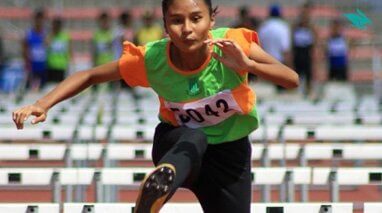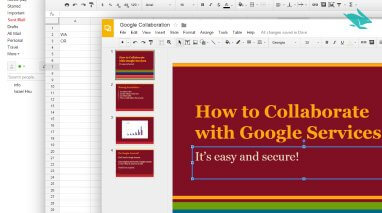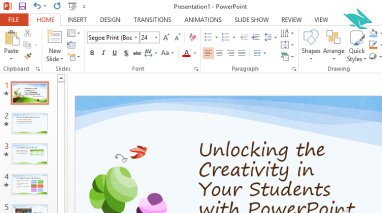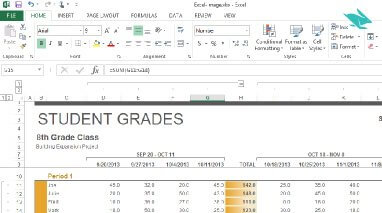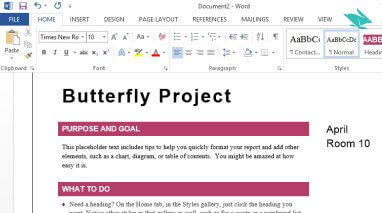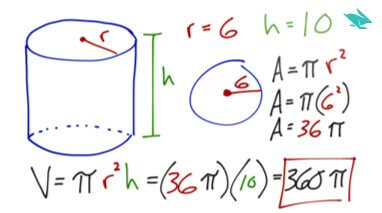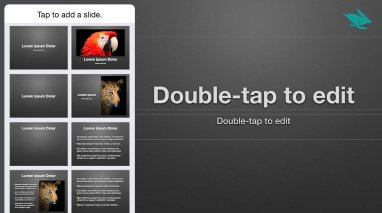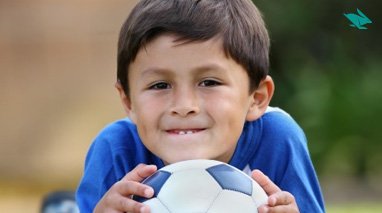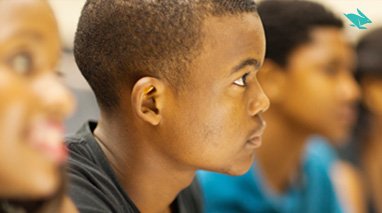-
 This class introduces you to the powerful and free Gmail and Google tools that not only enable you to email others, but also allows you to turn your classroom into an online writing, reading, analyzing, and collaborating environment. One teacher reported that after taking this class, trips to the copy machine were greatly reduced since now they know they could give assignments, list information, and get homework returned – all through Google’s tools.
This class introduces you to the powerful and free Gmail and Google tools that not only enable you to email others, but also allows you to turn your classroom into an online writing, reading, analyzing, and collaborating environment. One teacher reported that after taking this class, trips to the copy machine were greatly reduced since now they know they could give assignments, list information, and get homework returned – all through Google’s tools. -

Learn to create impressive presentations.
Microsoft PowerPoint is the world’s most commonly used presentation software. In this course, you will learn more than just how to use PowerPoint. You will also learn the secret to giving impressive presentations – to your classroom, to your open house attendees, and to decision makers. -

Learn to organize your life, your classroom, and your future with Microsoft Excel
Microsoft Excel is a spreadsheet program that will give you life a sense of order, consistency, and organization. From student rosters, to mathematics graphs, to your own budget – Excel is a great way to organize information and then visualize that information in meaningful ways. -
 This class will teach you how to use the world's most popular document processing tool - Microsoft Word. Starting from the basics of how to create a simple document and progressing all the way to learning how to create professional looking parent-teacher letters, compositions, brochures, and fliers, you will learn how to master Microsoft Word as well as how to create lesson plans that teach your students how to use Microsoft Word. For the busy professional, tips are given how to embed Microsoft Word assignments into your existing lesson plans.
This class will teach you how to use the world's most popular document processing tool - Microsoft Word. Starting from the basics of how to create a simple document and progressing all the way to learning how to create professional looking parent-teacher letters, compositions, brochures, and fliers, you will learn how to master Microsoft Word as well as how to create lesson plans that teach your students how to use Microsoft Word. For the busy professional, tips are given how to embed Microsoft Word assignments into your existing lesson plans. -
Sale!

Learn to make math problems relevant to the daily life of your students.
This class will feel like you are sitting at a dinner table with a group of teachers from different schools, talking about how to make math practical and relevant to students at your grade level. With this class, you will want to prepare yourself for learning up to 30 to 40 new websites and applications on the web that make math fun, engaging, and practical. -
Sale!
 Learn about and put into practice a proven effective instructional approach for preparing our students not just to face the real world, but to make it better! Project-Based Learning: Connecting Classrooms to the Real World offers teachers a convincing argument for implementing project-based learning (PBL) in their classrooms to promote success in academia, in future professions, and in life. Teachers will be equipped with practical tools and resources to take steps toward, or even fully dive into, a research-proven more satisfying and effective way to teach.
Learn about and put into practice a proven effective instructional approach for preparing our students not just to face the real world, but to make it better! Project-Based Learning: Connecting Classrooms to the Real World offers teachers a convincing argument for implementing project-based learning (PBL) in their classrooms to promote success in academia, in future professions, and in life. Teachers will be equipped with practical tools and resources to take steps toward, or even fully dive into, a research-proven more satisfying and effective way to teach. -
Sale!

Participants will develop an increased awareness of the need both nationally and locally to meet the need of ESL students, based on data and research. They will examine ESL standards in their particular state, as well as instructional shifts from traditional approaches to alternative approaches, particularly through the use of technology. They will learn to foster academic interactions, specifically academic conversation skills. They will practice technology usage and create definite plans to incorporate specific tools into ESL lessons to create and increase authentic opportunities for students to interact in meaningful ways.
Key deliverables include: written responses reflecting participants’ analysis of ESL demographic data, current ESL state standards, and instructional practices; practice of, and reflection about, constructive academic conversations and technology tools in the classroom, specifically to promote ESL mastery; creating a lesson plan that incorporates learning into classroom practices; course summary with practical application and reflection. Key activities include reading, watching videos, researching, reflecting, analyzing, and planning. -
 This course targets meeting the needs of diverse learners in general and special education classrooms, particularly through strategic grouping. In order to group students most effectively, even in order to successfully teach students, it is imperative that teachers conscientiously get to know each student as much as possible. Often students’ strengths go unrecognized, and many needs go unnoticed, frustrating the teaching and learning process. When strengths are celebrated and deep needs are validated in students, their best efforts, abilities and character can be evoked. The course provides an overview of federal laws and regulations related to meeting the needs of students, as well as various needs that require the accommodation of teacher. Strategies are listed, but the bulk of the course discusses the component of arranging groups to meet students’ needs and to bring out their strengths. The course examines specific grouping options for particular dynamics and learning results. The course ends with an argument for maximized inclusion for students, as well as Dr. Sara Lawrence-Lightfoot’s model of portraiture in the field of education, to find ways of discovering, defining, and bringing out the goodness that is present in every student.
This course targets meeting the needs of diverse learners in general and special education classrooms, particularly through strategic grouping. In order to group students most effectively, even in order to successfully teach students, it is imperative that teachers conscientiously get to know each student as much as possible. Often students’ strengths go unrecognized, and many needs go unnoticed, frustrating the teaching and learning process. When strengths are celebrated and deep needs are validated in students, their best efforts, abilities and character can be evoked. The course provides an overview of federal laws and regulations related to meeting the needs of students, as well as various needs that require the accommodation of teacher. Strategies are listed, but the bulk of the course discusses the component of arranging groups to meet students’ needs and to bring out their strengths. The course examines specific grouping options for particular dynamics and learning results. The course ends with an argument for maximized inclusion for students, as well as Dr. Sara Lawrence-Lightfoot’s model of portraiture in the field of education, to find ways of discovering, defining, and bringing out the goodness that is present in every student. -
Sale!

This class is based on sound research that has been done by researchers throughout the nation, to show tangible ways to promote the academic achievement of African American and Latino boys and girls.
This class will equip teachers with practical, in classroom methodologies that have shown to advance the academic performance of students of color. Based on the work of researchers such as Claude Steele, Tyrone Howard, Pedro Noguera, Gloria Ladson-Billings, Johnnie McKinely, Gary Howard and Baruti Kafele, this class takes a constructivist and research based approach toward helping educators recognize and combat the negative affect of implicit stereotype thinking and master skills needed to remove barriers to K-12 student learning. As the number of students of color increase in the school districts across the nation, teachers are looking for methods that “move the needle” for advancing the academic performance of African American and Latino students. Teachers will learn how to build counter narratives to inferiority complexes that students harbor and see examples of teachers and schools that are closing the achievement gap through in-classroom practices that work. Although the class focuses much of the material on African American students, the class is structured to provide conceptual frameworks and practices that work across cultures. Each lesson gives clarification for how to apply certain principles to Latino and other students of color. Educators will also learn key facts such as: a) You don’t have to be black to teach black students; b) Holding students to high standards is one of the best ways to break down stereotypes and improve academic performance and c) many other principles and methods that have scientifically been shown to help students learn and perform at high levels. Please check with your school district or local authority on whether the kind of credit this course provides can be used towards meeting your professional development, salary differential, or credential renewal needs. For questions, email support@quikitech.com. Syllabus
